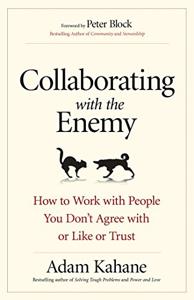
Want to learn the ideas in Collaborating With the Enemy better than ever? Read the world’s #1 book summary of Collaborating With the Enemy by Adam Kahane here.
Read a brief 1-Page Summary or watch video summaries curated by our expert team. Note: this book guide is not affiliated with or endorsed by the publisher or author, and we always encourage you to purchase and read the full book.
Video Summaries of Collaborating With the Enemy
We’ve scoured the Internet for the very best videos on Collaborating With the Enemy, from high-quality videos summaries to interviews or commentary by Adam Kahane.
1-Page Summary of Collaborating With the Enemy
“Collaborating”
We must collaborate with others in our lives, including people we don’t like and even those who dislike us. We may have to work with enemies to achieve mutual goals. People from different groups often face the challenge of resolving seemingly non-negotiable differences. However, political foes Nelson Mandela and F.W De Klerk were able to reconcile their differences for the greater good of South Africa by ending apartheid together.
Collaboration is a great way to solve problems, but there are times when collaboration isn’t possible. The people in that case must choose from three alternatives: 1. “Forcing” – People use this power move when they think they can unilaterally impose their ideas and solutions on others. They disregard other people’s views and seldom collaborate with them.
Collaborate & Compromise – When the opposing parties equally possess power, rather than force their own opinions or dictate outcomes, they tend to negotiate mutually acceptable agreements through cooperation and compromise.
Accommodating – If one party has more control over the situation, he/she may employ this strategy by giving into the requests of another party without resistance because it serves his/her interest to do so.
People have three ways to deal with situations. Some people adapt and make the best of whatever they have in front of them, even if it’s not ideal. If that doesn’t work for them, some people quit or divorce themselves from the situation.
Talking and Listening
Collaboration is important, because it allows people to work together and achieve common goals. However, collaboration can be difficult when relationships between team members are strained. People often communicate in four different ways: 1. “Presencing” – This approach involves looking towards the future and talking about what could happen or what might be possible if certain conditions are met. 2. “Dialoguing” – This style of communication focuses on empathy for others by saying things like, “I hear where you’re coming from…” 3. “Downloading” – In this mode of conversation, people assert their position without regard to other viewpoints by saying things like “The truth is…”
- Debating is a common way to interact with people. It means you’re making judgments on the content of the conversation and not collaborating. Downloading information without adding anything to it reinforces what we already know, whereas dialoguing helps us learn something new from each other.
“Stretch Collaboration”
People often don’t work with their opponents because they misunderstand what collaboration means. They think it only occurs among colleagues who are glad to work together and attain shared goals, but that’s not the case in stretch collaboration. You can still be effective even if you’re working with your rivals.
Stretch collaboration is a way to work together with others even if you don’t have control over the outcome. It’s about working out differences and finding solutions that everyone can agree upon. Instead of trying to reach perfection, it’s about finding a solution that works for all parties involved.
To achieve success with collaboration, we must focus on three dynamics. First, successful collaborators don’t adjust to their counterparts; instead they understand that harmony isn’t the point. Instead, they focus on achieving successful dealings and connecting with people who may even be their enemies.
- The best collaborators are not stubborn and rigid. They don’t expect everyone to agree on the problem, solution, and plan. Instead they’re willing to experiment with different perspectives until they reach acceptable goals.





